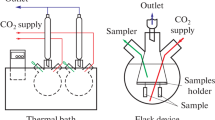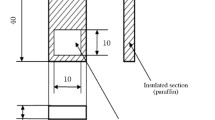Abstract
Coiled tubing (CT) is known to be susceptible to corrosion due to the complexity of wellbore environment and limited material selection. Since the weld seam (WS) and the base metal (BM) of CT are different in composition and microstructure, WS material usually shows very different (lower) corrosion resistance compared with BM. To better understand the corrosion-related behaviors of CT materials and the mechanism behind them, the WS and BM samples were directly processed from a finished product of CT, and a series of electrochemical experiments were conducted in laboratory conditions to study the corrosion behaviors of both WS and BM materials. The results showed that the corrosion potentials of BM and WS under the condition of 60 °C and saturated CO2 increased by 57.1% and 41.6%, respectively, comparing with the condition of no CO2 presence. Also the corrosion current of the WS was found to be 14 times of the BM’s. A corrosion model was established assuming the principles of galvanic couple corrosion applied on the working conditions of CT. The surface morphologies of the samples were analyzed by the multi-physical field coupling method. The results showed a very good consistence between the corrosion model and the experimental data. Meanwhile, this model was also used to evaluate the impacts of the welding reinforcement, the area ratio of WS and BM, and the material defects on their corrosion rates. The results indicated that the area ratio of WS and BM is in direct proportional to the corrosion rate, and the other two parameters showed very little effect.















Similar content being viewed by others
References
H. Wang, X. Zhang, L. Xian et al., Coiled tubing. J. Pet. Sci. Technol. 36, 1002-302x (2017)
S. Liu, H. Xiao, F. Guan et al., Coiled tubing failure analysis and ultimate bearing capacity under multi-group load. Eng. Fail. Anal. 79(9), 803–811 (2017)
F. Yin, K. Cui, D. Zhang et al., Application status and prospect of coiled tubing technology. J. Inner Mongolia Petrochem. Ind. 39(18), 95–97 (2013)
R.K. Stanley. An analysis of failure in coiled tubing. Paper 39352 presented at the IADC/SPE Drilling Conference, Dallas, TX, 3–6 March 1998, Dallas, Texas, USA. New York: IADC/SPE (1998)
A.R. Crabtree, W. Gavin, Coiled tubing in sour environment—theory and practice. J. SPE Drill. Complet. 20(01), 71–80 (2005)
A.R. Crabtree. CT-failure monitoring: a decade of experience, in SPE/ICoTA Coiled Tubing and Well Intervention Conference and Exhibition (Society of Petroleum Engineers, 2008)
L. Wan, Y. Meng, F. Liang et al., CO2 corrosion and its influence factors in oil/gas field exploitation. J. Total Corros. Control 02, 14–17 (2003)
L. Guo, H. Zheng, S. Liu et al., Effect of heat treatment temperatures on microstructure and corrosion properties of Inconel 625 weld overlay deposited by PTIG. Int. J. Electrochem. Sci. 11, 5507–5519 (2016)
M. Chen, H. Zhang, et al. Study on electrochemical corrosion behavior of welded joint of CT80. J. Hot Work. Technol. 47(15), 195–198 + 203 (2018)
S. Liu, G. Feng, W. Xianjin et al., Theoretical and experimental research of bearing capacity and fatigue life for coiled tubing under internal pressure. Eng. Fail. Anal. 104(10), 1133–1142 (2019)
C. Huan et al., The Research of the Coiled Tubing Corrosion Life (China University of Petroleum, Beijing, 2016)
C. Wang et al., The Corrosion Evaluation of the Domestic Coiled Tubing (Xi’an University of Technology, Xi’an, 2012)
F. Sun, G. Zhao, Q. Guo et al., Corrosion resistance of QT-900 coiled tubing in different sections of well. J. Hot Work. Technol. 44(06), 56–59 (2015)
C. Wang, L. Feng et al., Study on impact factors of continuous oil tubes in simulated oil field environment. J. Corros. Prot. Petrochem. Ind. 29(5), 7–9 (2012)
L.A. Magadova, L.F. Davletshina, O.Y. Yefanova, et al. The problem of investigation of coiled tubing corrosion during acid treatment. J. Oil Gas Technol. 79(2), 12 (2012)
K.B. Deshpande, Validated numerical modelling of galvanic corrosion for couples: magnesium alloy (AE44)-mild steel and AE44aluminium alloy (AA6063) in brine solution. J. Corros. Sci. 52, 3514–3522 (2010)
Y. Lu, H. Jing, Y. Han et al., Numerical modeling of weld joint corrosion. J. Mater. Eng. Perform. 25, 1–6 (2016)
Y. Lu, W. Li, H. Jing, et al. Finite element simulation of carbon steel welded joint corrosion. Trans. China Weld. Inst. 39(5), 10–14 + 129 (2018)
W. Li, Z. Sun, Y. Lu et al., Study on galvanic corrosion behavior of carbon steel pipe welded joints. J. Weld. Technol. 45(07), 19–21 (2016)
W. Li, Z. Sun, Y. Chen et al., Research on the electrochemical corrosion behavior of carbon steel pipe welded joint. J. Welded Pipe Tube 38(05), 46–49 (2015)
M. Liu, Y. Xue, T. Gao et al., Electrochemical corrosion behavior of a CT80 CT steel in 6 °C salinity solution. J. Corros. Sci. Prot. Technol. 25(03), 213–218 (2013)
Z. Bi, P. Zhang, X. Jing, et al. Study on corrosion behavior of coiled tubing in east Sichuan gas field. J. Welded Pipe Tube 34(4), 26–28 + 40 (2011)
X. Qiu, et al. Research on the internal corrosion behavior of 316L Clad pipes in Tarim typical CO2. Southwest Petroleum University (2017)
A. Stenta, S. Basco, A. Smith, et al. One-dimensional approach to modeling damage evolution in galvanic corrosion. J. Corros. Sci. 88, 36–48 (2014)
F. Wang, W. Kang, H. Jing et al., Corrosion Electrochemical Principles, Methods and Applications (Chemical Industry Press, Beijing, 2008)
G. Rocchini, Evaluation of the electrochemical parameters by means of series expansion. J. Corros. Sci. 36(8), 1347–1361 (1994)
Q. Xingdong, Research on the internal corrosion behavior of 316L Clad pipes in Tarim typical CO2 gas fields (Southwest Petroleum University, Chengdu, 2017)
X. Zhang, S. Gao, W. Wu et al., Finite element analysis of influence of weld reinforcement on fatigue life of welded joints. J. Hot Work. Technol. 46(01), 189–194 (2017)
X. Lü, Z. Zhang, A. Li et al., Influence of pile high on fatigue strength of welding joint. J. Chem. Anal. Meterage 20(S1), 62–65 (2011)
C. Wang, Y. Ge, Y. Qian et al., Weld reinforcement control measures for longitudinal submerged arc welded pipe. J. Welded Pipe Tube 36(05), 54–57 (2013)
B. Cui, Y. Peng, H. Xiao, et al. Effects of weld thermal cycle on microstructure and properties of heat-affected zone of Q890 processed steel. J. Trans. China Weld. Inst. 38(7), 35–39 + 130–131 (2017)
Y. Weng et al., Corrosion Prediction and Metrology Foundation (Petroleum Industry Press, Beijing, 2011)
Acknowledgments
This work of the paper was supported by the Natural Science Foundation of China (Nos. 51974036, 51604039), the Yangtze Fund for Youth Teams of Science, and Technology Innovation (No. 2016cqt01).
Author information
Authors and Affiliations
Corresponding author
Ethics declarations
Conflict of interest
None.
Additional information
Publisher's Note
Springer Nature remains neutral with regard to jurisdictional claims in published maps and institutional affiliations.
Rights and permissions
About this article
Cite this article
Shaohu, L., Yuanliang, L. & Hong, Z. Corrosion Failure and Electrochemical Corrosion Behavior of Coiled Tubing. J Fail. Anal. and Preven. 20, 1964–1974 (2020). https://doi.org/10.1007/s11668-020-01007-4
Received:
Revised:
Published:
Issue Date:
DOI: https://doi.org/10.1007/s11668-020-01007-4




